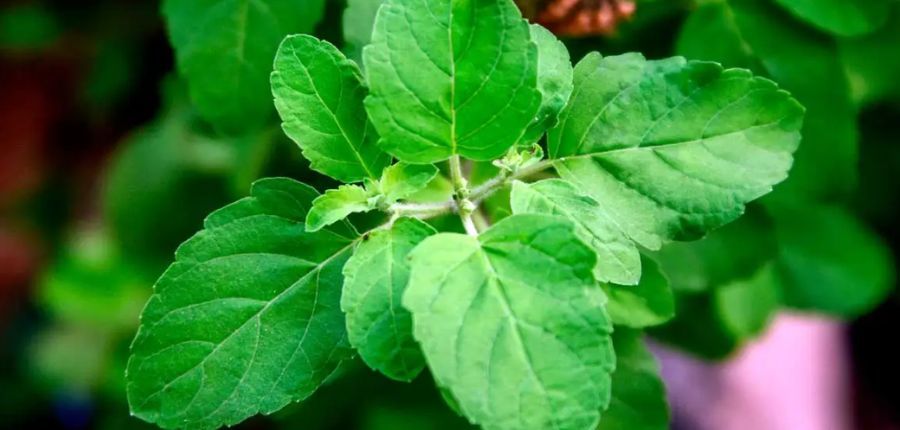Basil leaves are very well known in India, and almost every Indian house has them. Basil is also used for cooking and worship. Every morning, many Indians worship basil plant. The plant has been grown regionally in India for over 5,000 years or perhaps more.
In the 1500s, India was taken to England. The plant was brought to the United States in the early 1600s. Basil leaves are best cultivated in warm climates, mostly in India, Madagascar, Pakistan, Haiti, Indonesia, Thailand, France, Morocco, Egypt, and South Africa.
Basil’s scientific name is Ocimum basilicum L. It is a member of Lamiaceae’s family. The term Ocimum is derived from the Greek word Okimon which means “smell.” The term Babui Tulsi is used in Hindi and Bengali.
1. Basil Leaves For Cancer:
Flavonoids like vicenin and orientin in basil leaves may help against cancer by protecting the cells and chromosomes against radiation and oxidative DNA damage. It may also help in the removal of mutagens and carcinogens due to various chemicals.
Basil leaves may also act against fibrosarcoma, skin papilloma and some oral cancers. Nevertheless, most of the above studies are conducted on animals. As a result, you ought to obtain proper treatment rather than self-medication.
2. Basil Leaves For Diabetes:
Basil leaves may have anti-diabetic characteristics as seen in a clinical survey basil leaves lowered blood glucose levels and urine glucose levels. It may also prevent the complication of diabetes such as retinopathy and cataract. However, large-scale clinical trials are required to determine their efficacy.
3. Basil Leaves For Bacterial Infections:
Basil leaves may contain several aromatic essential oils. Examples of aromatic compounds are linalool, eugenol, citral, and limonene. These compounds may act against bacterial infections by damaging bacterial cell walls and causing the death of bacteria.
Some aromatic compounds inhibit the growth of certain bacteria. However, additional studies are necessary to determine the anti-bacterial action of basil leaves.
4. Basil Leaves To Reduce Swelling:
In traditional methods, basil leaves may be used against swelling. The anti-inflammatory characteristics of basil leaves may be due to the presence of eugenol. Eugenol may do this by preventing the activity of cyclooxygenase (COX), an enzyme responsible for inflammation.
It may also suppress inflammation by inhibiting the release of mediators (e.g. nitric oxide) and pro-inflammatory cytokines.
5. Basil Leaves For Increased Immunity:
A paper by Mukherjee, S., Lopes, M., et al. 2005 showed that the essential oil from basil leaves can boost cellular and humoral immunity. In cellular immunity, there is no production of antibodies.
At the same time, antibodies are being created in humoral immunity. Basil leaves help in producing antibodies and it also discharges mediators. Therefore, basal leaves are more likely to assist the immune system.
6. Basil Leaves To Manage Stress:
Calming stress was alleviated by basil leaves. Thus it is likely to have an excellent rejuvenating capacity that may assist it unwind and reduce tension. It could also help to improve memory.
Basil leaves have relieved tension due to their anti-hypoxic properties. Thus it is likely to be concluded if basil leaves contribute to stress management.
7. Basil Leaves For Arthritis:
Since fixed oils are thought to play a role in the inhibition of substances that give rise to inflammation, basil leaves may have anti-arthritic potential. Basil leaf fed rats reveal considerable action compared to those that were untreated in the limits of the experiment.
More research is necessary to see if it is feasible in humans. Nevertheless, if you get unbearable discomfort due to arthritis, consult your doctor instead of overmedicating.
8. Basil Leaves For Heart Health:
Basil leaves might promote heart health and reduce LDL and triglycerides. LDL and triglycerides are two types of fats that clog blood vessels and cause a heart attack, stroke, and atherosclerosis.
Basil leaves can also slow platelet aggregation. So basil leaves may decrease heart disease risks such as heart attack and stroke by reducing LDL and triglyceride levels.
But to confirm that basil leaves affect the heart, extensive large studies are required. If you find any sign of heart disease, consult a doctor immediately.
How To Use Basil Leaves?
- Basil leaves could be used in the food items like condiments, sauces, stews, soups, vegetables, fish, and meat.
- Basil might be employed for flavor foods along with different herbs like oregano, garlic, mustard, parsley, rosemary, and thyme.
- They could be put in tea and cheese.
- Essential oils of basil could be noted in a variety of drinks and prepared foods.
Side Effects Of Basil Leaves:
Basil Leaf has no particular side effects due to its use. However, if someone has taken it in extra quantity, such side effects can appear. If you feel the side effects of taking basil, consult a medical practitioner right away. Rest, you ought to ask your Ayurvedic physician who prescribes basil leaves.
SIMILAR ARTICLES:
REFERENCES:
- Tulsi – Ocimum sanctum: A herb for all reasons; Author: Marc Maurice Cohen; PMCID: PMC4296439, PMID: 25624701.
- Basil: A natural source of antioxidants and neutraceuticals; Authors: Masoud Yahya Al-Maskari and Muhammad Asif Hanif;
- Basil: A Brief Summary of Potential Health Benefits; Author: Keith Singletary; ResearchGate.
- Chemical components and pharmacological benefits of Basil (Ocimum basilicum): a review; Mohamad Hesam Shahrajabian; Pages 1961-1970 | Received 01 Jun 2020, Accepted 19 Sep 2020, Published online: 08 Nov 2020.
